I have two systems that run on separate power supplies and turn on independently of each other.The issue here is that each system needs to be cooled by the same cooling fan. So I need to know if there is a way that I could have either system on and the cooling fan turn on for either one. Also need to be able to have both on without overvolting the fan. I also really dont want to run another power supply just for the fan and have to turn it on independently of the systems. Thank you all for any help. The fan is rated at 12V but can be ran at about 5V. One of the power supplies is 5V and the other is 7V. Also, what would I do with the negative wire in this situation? Is it fine to have it connected to only one of the power supplies or should I have it configured a different way?
-
3Quick answer: use a diode OR. Two diodes, one from one supply the other from the other supply. (Assumes systems each run on suitable supply for the fan) – Puffafish May 02 '17 at 16:04
-
If its a BLDC fan you have a very ugly switched inductive load (they swing from 0 to full current on a cycle), I'd be careful using diodes – Voltage Spike May 02 '17 at 18:35
3 Answers
Assuming both power sources are withing the fan´s working range, and that they have enough power for the fan and all other loads when running alone:

simulate this circuit – Schematic created using CircuitLab
The maximum voltage in the fan will be the highest voltage between both power supplies. The voltage will not add to each other.
So if you have 12V on V1 and 5V on V2, then when V1 is turned on (with V2 on or off), your fan will run at 12V, and when only V2 is turned on, your fan will run at 5V
If your fan is causing interference or noise, use a big enough filter capacitor. The easiest here is to read your power signal before the diodes and check for noise when the fan turns on and off, and tweak the capacitor value accordingly.
I would also put a protection diode, so that any back EMF from the fan has a path to leave the circuit.
- 662
- 6
- 10
-
Might I suggest suggesting 1N4007 diodes instead of the 1N4148 part? As we don't know the OP's fan's current, the former is more likely to be suitable. And it reduces the BOM. – Andrew Morton Jun 05 '17 at 17:37
-
1Sure... but I hope the OP checks the components' technical properties before application :P – cyberponk Jun 05 '17 at 18:07
-
they are 12V fans that will be ran realistivally at about 5-7V so they aren't so loud. they should pull a max of 0.5A. Also as a prettyy noob question, what would I need to do to the negative wires? – Jun 15 '17 at 01:55
-
Personally I would go for Schottky diodes. Lower forward voltage drop means more chance of the fan getting enough voltage to work properly. – Peter Green Jun 16 '17 at 00:01
You'll want to do something like this. Of course, you'll have to get the properly rated relay and possibly step down the power to it's coil.

- 11
- 1
The most general solution would be to connect a SPST relay to each system, and wire the contacts in an "OR" configuration to switch the fan on. This allows all three power supplies (the two systems and the fan) to remain galvanically isolated from each other.

simulate this circuit – Schematic created using CircuitLab
The relay coils need to be rated for the system power supplies, and the contacts need to be rated for the fan. They could be mechanical relays or solid-state relays, as appropriate.
- 168,369
- 17
- 228
- 393
-
2The asker specifically said they don't want to add another power supply just for the fan. I think a diode-or would be more suited to the task. – Hearth May 02 '17 at 18:07
-
Diodes might not work very well depending on the fan, plus you have losses from the diodes. – Voltage Spike May 02 '17 at 18:36
-
1@Felthry: As I said, this is the most general solution, putting the fewest constraints on the existing systems (or the fan itself). It was not specified what voltages the two systems operate on, or even whether they were AC or DC. The diode solution presupposes that they are DC and that their grounds can be tied together. – Dave Tweed May 02 '17 at 20:07